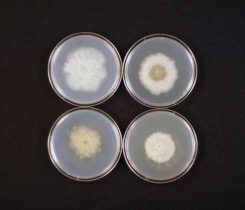Review of 2018: Problematic diseases and fungicide efficacy testing

Brian Aynardi
Weather in the 2018 growing season varied widely by region. The Midwest and parts of the western United States were dry throughout most of the summer and into the fall. Meanwhile, the eastern U.S. saw one of the wettest years on record, particularly east of the Appalachian Mountains. Accordingly, much of the eastern seaboard turned into a superintendent’s worst nightmare, with many diseases remaining active for continued periods and poor conditions for turf recovery.
A variety of diseases caused significant problems for turfgrass managers throughout the eastern part of the country in 2018, including: anthracnose, brown patch, dollar spot, gray leaf spot, mini-ring, summer patch, Pythium foliar blight and Pythium root rot. Commercially available products were given a true test in the field, both for efficacy and longevity. Remember that the best pathogen control (and subsequent disease control) doesn’t come from a single product, but from the integration of various products with effective MOAs. This article will review fungicide efficacy from results in various university and private contracting tests, in addition to notable observations from the field regarding disease control.
Anthracnose, found especially on Poa annua greens in the mid-Atlantic and northeastern U.S., was as usual, a problem in 2018. Various products provided effective control of Colletotrichum cereale in field trials, including: Tekken broad spectrum fungicide (PBI-Gordon), Fame + C (FMC), Tartan Stressgard (Bayer Crop Science), Velista (Syngenta Crop Protection), as well as the new active ingredient mefentrifluconazole, which is currently in registration. This active was effective as a standalone called Maxtima, as well as part of a premix with pyraclostrobin (BASF). Strobilurin fungicides and premix products with this group of fungicides are very effective, except where resistant strains of C. cereale are present. Don’t forget: Regularly spoon-feeding the plant with quick-release nitrogen in conjunction with your fungicide program is one of the best courses of action in controlling anthracnose.
Brown patch thrived in bentgrass and tall fescue in 2018, and a variety of active ingredients provide excellent control of Rhizoctonia solani. New to the market in 2019 will be Pedigree Fungicide SC, a nongeneric SC formulation of flutolanil (PBI-Gordon). This joins other standby brown patch products, including Tekken, Exteris Stressgard (Bayer Crop Science), Velista and Navicon (currently in registration).
Dollar spot exploded in many places early in the season and persisted into early fall. Resistance of Clarireedia spp. to SDHI fungicides further complicated control options, as there is already documented resistance to benzimidazoles, dicarboximides and demethylation inhibitors. If you believe you have an SDHI-
resistant population, it is highly recommended that you get it tested by a university.
Resistance among SDHI fungicides is caused by various mutations, and some active ingredients within that group will perform better than others based on the specific mutation. That said, in areas where SDHI insensitivity (or resistance) is occurring, premix products or tank mixes with an additional mode of action provided excellent control. For example, Tekken features two active ingredients (isofetamid + tebuconazole) that both provide strong control of dollar spot. Tekken performed very well at both university trials and in the field, providing up to 28-day control.
Gray leaf spot was problematic in 2018 — not surprising with the excessively wet and humid environmental conditions. This disease is found on St. Augustinegrass and tall fescue, but it is very damaging to perennial ryegrass. No single product provides absolute control of the pathogen. Strobilurin fungicides are strong control tools except among populations resistant to this class. Inclusion of thiophanate-methyl or chlorothalonil (various manufacturers) into a control program or tank mix is essential for disease management.
Mini-ring, formally referred to as Rhizoctonia leaf and sheath blight, seems to be an increasing issue on bermudagrass greens. Research trials with North Carolina State University and Clemson University demonstrated that different locations resulted in varying levels of control with two products, Pedigree and Heritage Action (Syngenta Crop Protection). However, Tekken as a curative treatment provided excellent control in both trials.
The pathogen causing summer patch (Magnaporthiopsis poae) begins to cause infection when soil temperatures are approximately 65°F at the 2-inch soil depth. However, symptoms are not observed until hot, wet weather appears in the summer. These conditions were common in 2018, and testing at several university locations demonstrated excellent control from Tekken, Fame + T (FMC), Briskway (Syngenta Crop Protection), Headway and Navicon (currently in registration).
Frequent rains out east in conjunction with warm, humid air provided ideal conditions for Pythium blight development from June through August. The best control was found with Segway Fungicide SC (PBI-Gordon). Since its inception, Segway has consistently provided complete or near complete control in university testing. Of the products currently in federal registration, Union fungicide (PBI-Gordon) provided exceptional control of Pythium blight. This premixture of Segway (cyazofamid) plus azoxystrobin will offer broad-spectrum disease control in addition to unsurpassed control of Pythium diseases. Banol (Bayer Crop Science) and Subdue MAXX (Syngenta Crop Protection) are excellent rotational partners with Segway.
Pythium root rot is a major problem on creeping bentgrass and mixed bentgrass/Poa putting greens, especially those with poor drainage. As with other root diseases, infection by the pathogen begins earlier in the growing season but symptoms become especially apparent when significant water and heat become prevalent. Segway is the gold standard in root-rot control, although alternating with strobilurin fungicides and rotating with Banol + Signature or Subdue MAXX is highly efficacious. Union fungicide was also a standout with both preventive and curative control of Pythium root rot.
Weather conditions in the East provided the necessary environmental component for the development of various diseases. While end users have a variety of products available for disease control, travels to various research locations and a review of the results of 2018 trials show the products mentioned in this review were top performers. Remember, one product alone is not the solution. Rather, it is the integration of top-performing products into a well-developed program that not only yields the best results, but also acts as a deterrent for resistance development.












